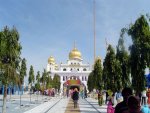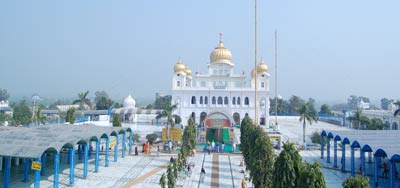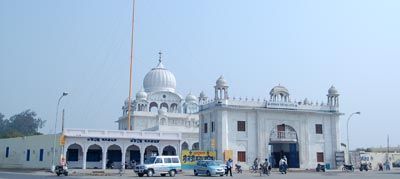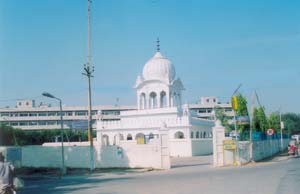<TABLE cellSpacing=0 cellPadding=0 width="100%" border=0><TBODY><TR><TD vAlign=top align=left width="100%" height=2>
<TABLE cellSpacing=0 cellPadding=0 width="100%" border=0><TBODY><TR><TD vAlign=top align=left width="100%" height=2>
Gurudwara's at Chamkaur Sahib
Gurudwara Sri Chamkaur Sahib - Disti. Ropar
</TD></TR><TR><TD vAlign=top align=left width="100%" bgColor=#333333></TD></TR><TR><TD vAlign=top align=left width="100%" bgColor=#ffffff></TD></TR></TBODY></TABLE>
This Gurdwara commemorates the historical battle- fought by Guru Gobind Singh in a small fortress. He faced a mighty Mughal army with just forty Sikhs. On the same spot,the great Guru blessed his two elder sons Ajit Singh and Jujhar Singh, saw them off to the battle field and exhorted them to attain spiritual perfection by sacrificing their lives. The two Sahibzadas and 37 Sikhs,attained martyrdom in the battle. Here stands a pillar,on which the words breathing the spirit of determination in the battle field are inscribed.
There are five historical Gurdwaras at Chamkaur. Gurdwara Garhi Sahib, stands at a place, where once stood a haveli of one Chaudhri Garibu. This was converted into a fortress by Guruji to face the larger Mughal hostile force.
Another Gurdwara is Tarhi Sahib. Here the Tenth Master left the Garhi along with his three devoted Sikhs at dead of night. The place where they clapped hands to announce the departure of the Guru, a memorial called 'Tarhi Sahib', has been raised. Gurdwara 'Katalgarh Sahib' commemorates the martyrdom of the Guru's two elder sons, Ajit Singh and Jujhar Singh, who displayed supreme valour and heroism and perished while fighting against formidable odds.
Gurudwara Qatalgarh Sahib (Shahid Ganj), west of Garhi Sahib, is the main shrine at Chamkaur Sahib. This marks the site where the thickest hand to hand fight took place on 7 December 1705 between the Mughal army and the Sikhs, including the Sahibzadas, Ajit Singh and Jujhar Singh, and three of the original five Piare (the Five Beloved). A gurdwara was constructed here by Sardar Hardial Singh of Bela in 1831 but that building was replaced during the 1960's by a new complex raised under the supervision of Sant Piara Singh of Jhar Sahib and later of Sant Bishan Singh of Amritsar. The main building called Mariji Sahib is an elegant three storeyed domed structure standing upon a high base. The large divan hall contains an eight metre square sanctum. Another vast hall close by is called Akal Buriga. It was used for the daily congregations before Mariji Sahib was constructed. To the west of Akal Buriga is an old Baoli Sahib still in use. The Guru ka Langar, community kitchen, is further north from Baoli Sahib and Akal Buriga. The Gurdwara also houses the offices of the local managing committee which administers all historical shrines at Chamkaur under the overall control of the Shiromani Gurdwara Parbandhak Committee. In addition to the daily services, largely attended assemblies take place on the first of each Bikrami month and on important anniversaries on Sikh calendar. A three day fair called Shahidi Jor Mela is held on 6,7 and 8 Poh, usually corresponding with 20, 21 and 22 December, commemorating the martyrs of Chamkaur.
Gurdwara Garhi Sahib, Chamkaur Sahib, Dist. Ropar
</TD></TR><TR><TD vAlign=top align=left width="100%" bgColor=#333333></TD></TR><TR><TD vAlign=top align=left width="100%" bgColor=#ffffff></TD></TR></TBODY></TABLE>
This gurdwara commemorates the spot of the bloody battle of Chamkaur. After the attack at the river Sarsa, Guru Gobind Singh, his two eldest sons and 40 Sikhs made it to the town of Chamkaur while being pursued by an army of 1,000. Guru Gobind Singh and the 40 Sikhs sought shelter in a mud-built double story house. They were attacked by the enemy on December 22, 1705. Against these overwhelming odds, the Sikhs ventured our in small groups to fight the enemy and bravely lay down their lives. Thirty Seven Sikhs were martyred that day including Guru Gobind Singhs two eldest sons as well as three of the Five Beloved Ones (the first baptized Khalsa). Guru Gobind Singh himself was preparing for battle and martyrdom, but the five remaining Sikhs in the fort enacted the scene at Anandpur, where they were had the authority of Guruship and Gobind Singh their Khalsa disciple. Quoting the Gurus words giving them authority to issue resolutions, they ordered Guru Gobind Singh to escape the fort at night followed by three of the five remaining Sikhs.
Gurdwara Garhi Sahib is situated at Chamkaur Sahib in Ropar district and is connected by road to Ropar and Ludhiana-Chandigarh highway at Samrala and Morinda.
Gurdwara Garhi Sahib marks the site of the fortress like double storeyed house, with a high compound wall around it and only one entrance from the north, which was used by Guru Gobind Singh Ji as a temporary citadel in the unequal battle of Chamkaur on 7th December, 1705. While occupying the house during the night of 6-7 December, Guruji ordered 8 sikhs each to guard four sides.
While another two, Maan Singh and Kotha Singh was posted at the entrance. Guru Gobind Singh Ji, with his sons Ajit Singh and Jujhar Singh took position on the first floor of the house in the centre. Mughal now sorrounded the `Garhi'. The battle raged throughout the day. Sikhs started coming out in small batches to engage the enemy the hand to hand fight. Two such successive sallies were led by the Sahibzada Ajit Singh and Jujhar Singh, 18 and 14 years old respectively, who like the other sikhs fell fighting heroically.
By nightfall Guru Gobind Singh was left with only five sikhs in the fortress. These five sikhs urged him to escape so that he could rally his supporters again and continue the struggle against oppression. The Guruji agreed, he gave his own attire to Sangat Singh who resembled him in features and physical stature.
Under the cover of darkness Guruji made good his way through the encircling host slackened by the fatique of the day's battle. Daya Singh, Dharam Singh and Man Singh also escaped leaving behind only two sikhs, Sangat Singh and Sant Singh. Next day when, imperial trops entered the garhi, they were surprised to find only two occupants, who died rather than giving in. This place is also known as Tilak Asthan (Anointment Site) in the belief that Guru Gobind Singh Ji obeyed the five sikh here and gave his dress to Bhai Sangat Singh. Salana Jor Mela and Dussehra are celebrated here.
<TABLE cellSpacing=0 cellPadding=0 width="100%" border=0><TBODY><TR><TD vAlign=top align=left width="100%" height=2>
Gurudwara Katalgarh Sahib, Chamkaur Sahib, Dist. Ropar
</TD></TR><TR><TD vAlign=top align=left width="100%" bgColor=#333333></TD></TR><TR><TD vAlign=top align=left width="100%" bgColor=#ffffff></TD></TR></TBODY></TABLE>
During the battle of Chamkaur in 1704 in which the Guru and 40 Sikhs fought against overwhelming odds, both of Guru Gobind Singhs sons died in battle at this spot. The remaining Sikhs in the fort at Chamkaur were being martyred one by one, but they did not want the Gurus two sons to go into battle. Guru Gobind Singh declared that all the Sikhs in the fort were his beloved sons. During the battle Baba Ajit Singh asked his fathers permission to go out of the fort and fight the enemy. He said, Dear father, my name is Ajit or Unconquerable. I will not be conquered. And if conquered, I will not flee or come back alive. Permit me to go, dear father. Guru Gobind Singh hugged and kissed his beloved son before sending him into battle where he fought heroically until his last breath. Baba Jujhar Singh having watched his brother fight, asked Guru Gobind Singh, Permit me, dear father to go where my brother has gone. Don't say that I am too young. I am your son, I am a Singh or Lion of yours. I shall prove worthy of you. I shall die fighting, with my face towards the enemy, with God and the Guru on my lips and in my heart. Guru Gobind Singh embraced him and said, Go my son and wed life-giving Death. We have been here for a while. Now we shall return to our real home. Go and wait for me there. Your grandfather and elder brother are already waiting for you. Thus the Guru watched his two sons achieve eternal peace through martyrdom. Guru Gobind Singh was prepared to follow his sons and Sikhs in martyrdom, but it was not the great Gurus time yet.
<TABLE cellSpacing=0 cellPadding=0 width="100%" border=0><TBODY><TR><TD vAlign=top align=left width="100%" height=2>Gurudwara Tari Sahib- Chamkaur
</TD></TR><TR><TD vAlign=top align=left width="100%" bgColor=#333333>
</TD></TR><TR><TD vAlign=top align=left width="100%" bgColor=#ffffff>
</TD></TR></TBODY></TABLE>
GURDWARA TARI SAHIB is situated on a low mound to the west of Gurdwara Qatalgarh. When Guru Gobind Singh decided to leave the Garhi at Chamkaur during the night of 78 December 1705, three Sikhs, Bhai Daya Singh, Bhai Dharam Singh and Bhai Man Singh, came out with him, too. They proceeded each in a different direction, agreeing to meet later at a common spot guided by the position of certain stars. Since he did not wish to leave unannounced, Guru Gobind Singh, upon reaching the mound where now stands Gurdwara Tari (literally, a clap) Sahib, clapped and shouted: "Here goes the Pir of Hind (the saint of India)!" From their different points the three Sikhs also raised shouts. This baffled the besieging host, and Guru Gobind Singh and the Sikhs were soon gone out of harm's way. The Gurdwara on the mound marks the site from where Guru Gobind Singh had proclaimed his departure by hand clapping






